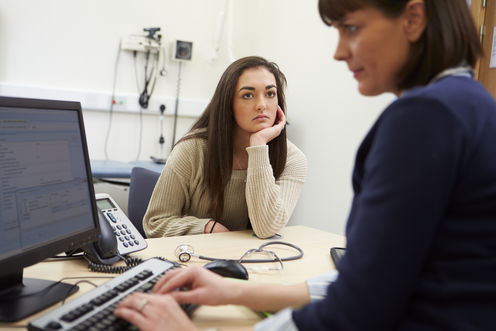
Women go to the doctor more often than men, particularly in their reproductive years, between the ages of 15 and 44. This difference is partly due to management of gynaecological and reproductive issues.
Because of the frequency of visits, and the sensitive nature of many of these, it’s important a woman has a good relationship with her general practitioner.
Why women go to the doctor
In a recent study, we found about 12% of problems managed for women of all ages in primary care concerned their reproductive or genital system.
Australian women visited a GP on average nearly seven times a year in 2013-14. For men, this figure was just under five times. Among those between 15 and 24, 83% of women – but only 68% of men – saw a GP at least once in any given year.
The frequency and type of these problems varied across age groups.
Throughout their lives, women experience different health issues. For instance, about 20% of women of childbearing age experience heavy bleeding during menstruation, and 15% have chronic pelvic pain. These numbers drop in older age groups.
Our study showed in the decade between 2004 and 2014, female-specific problems accounted for a quarter of all problems managed by GPs for women in childbearing years. This fell to only 10% of problems managed for those between 45 and 64 years, and 3% for those 65 and over.
Across all adult age groups, gynaecological check-ups involving pap smears were common. Other female-specific problems managed by GPs aligned with the life stages: pregnancy and contraception in younger women, menstrual problems and menopause in the middle and older age groups.
We found the most common problem managed overall for women between the ages of 15 and 64 was depression.
The most commonly prescribed medications were contraceptives and antidepressants.
Across all age groups, women were more likely to have depression than men and this was reflected in higher management by GPs.
For women 65 years and over, depression dropped down the list of problems, overtaken by a number of physical conditions. Pelvic floor disorders, such as urinary and faecal incontinence, affect about 50% of women aged 80 and older.
There are various theories about why women have higher depression rates. Environmental and biological influences, such as hormones, have been implicated, but studies on this aren’t conclusive.
Relationship with a GP
Some women feel embarrassed talking about female-specific issues, even with a health professional. One study showed only 32% of women aged 45 and over who had urinary incontinence actually mentioned this to their GP.
This is why having a regular GP is important. Studies show continuity of care in primary care is associated with better health outcomes.
Reassuringly, our study found women between 25 and 44 were more likely to attend a regular practice than men in the same age group. Across all age groups, more than 90% of women said they had a regular GP practice.
This is likely because they need repeated cervical cancer screening (pap smears) and contraceptive prescriptions, and management of chronic diseases in later years.
We hope future changes to cervical cancer screening (to replace two-yearly Pap smears with a five-yearly HPV test) and the push towards long-term contraception, despite their benefits, will not affect the relationship between women and their GP.
This article is part of our series examining hidden women’s conditions. You can also read today’s pieces on bacterial vaginosis and the need to empower women with appropriate language to seek help when their body “malfunctions”.
The authors do not work for, consult, own shares in or receive funding from any company or organization that would benefit from this article, and has disclosed no relevant affiliations beyond the academic appointment above.
